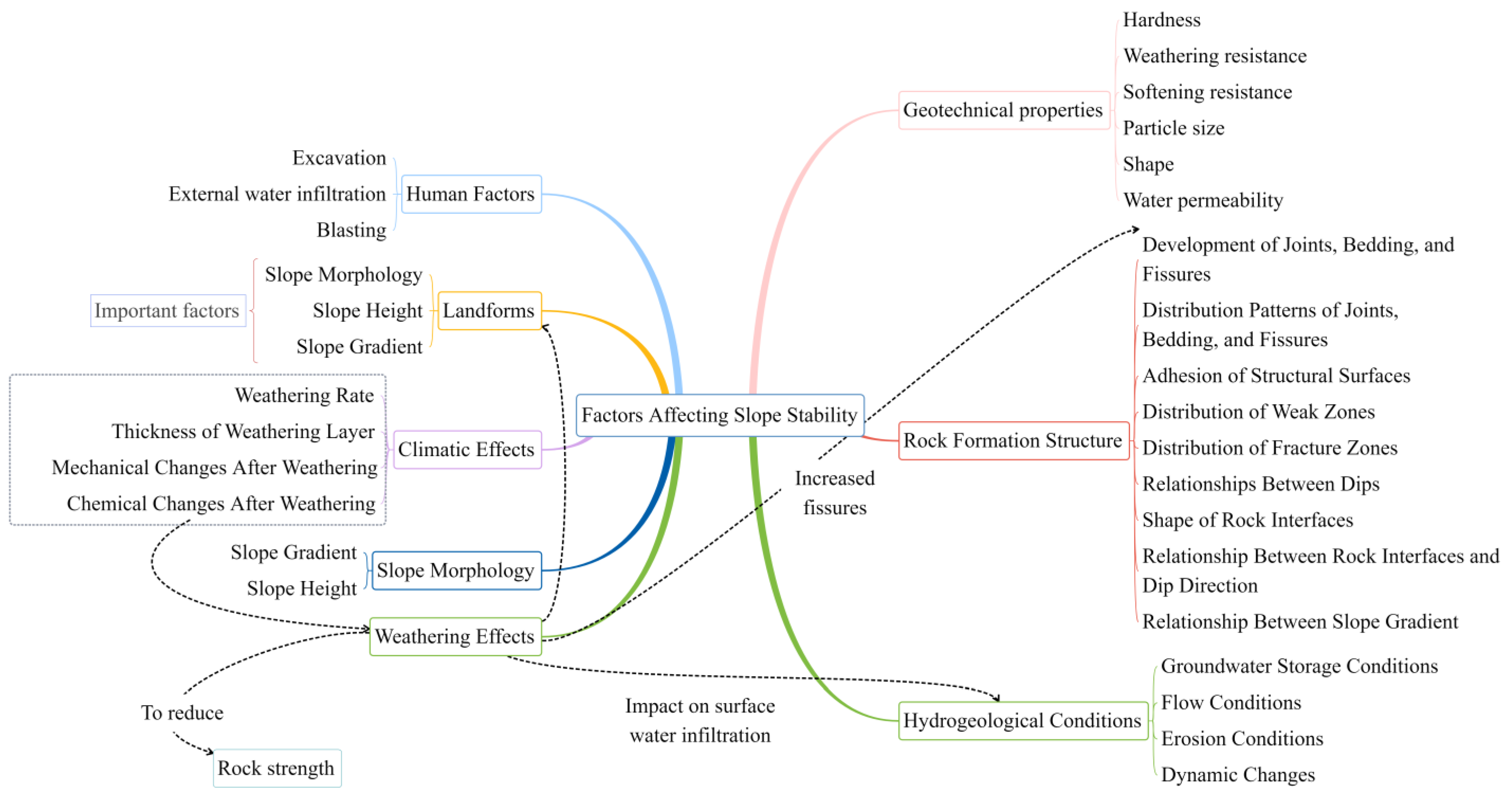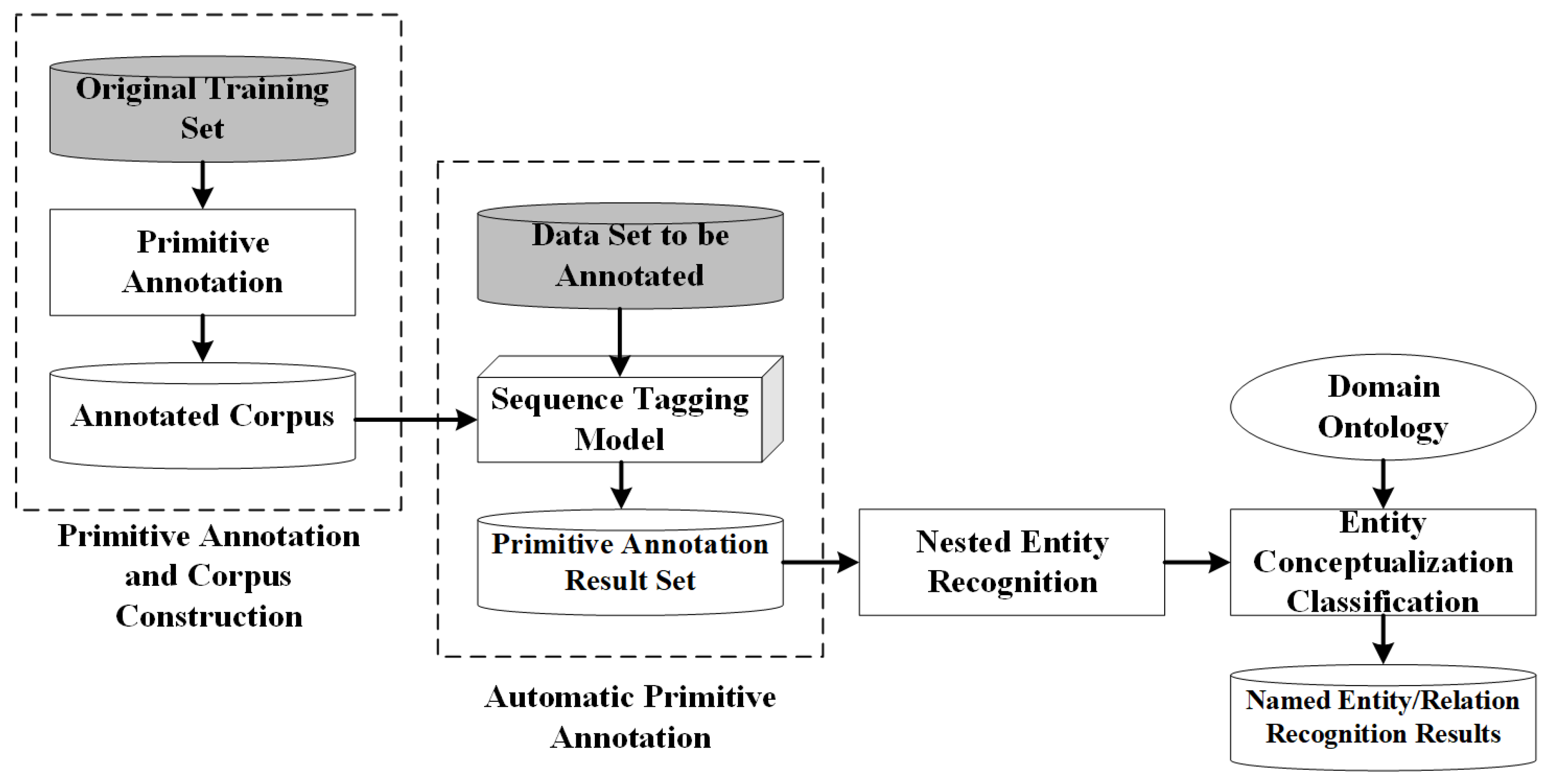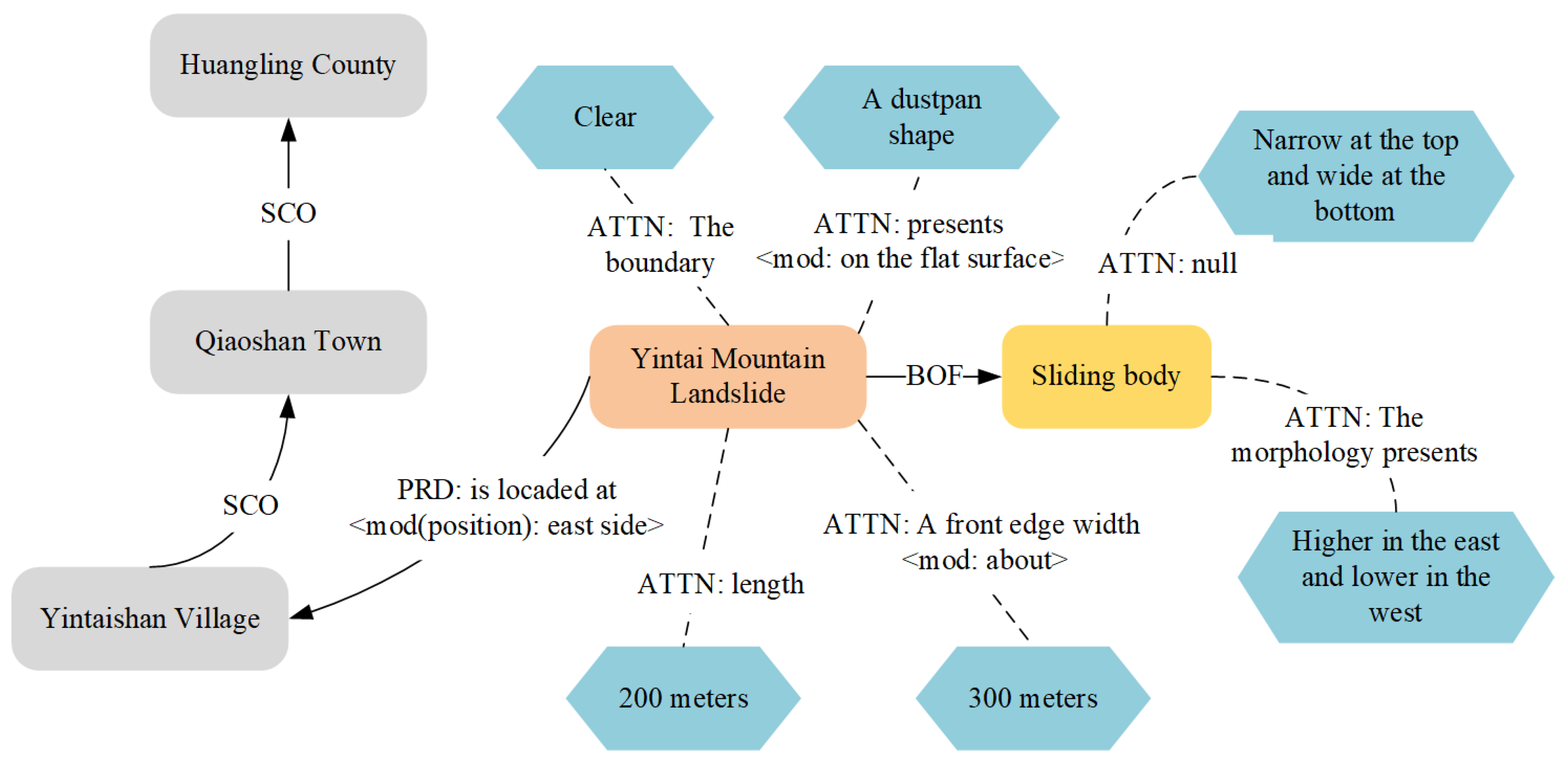Research on Intelligent Extraction Method of Influencing Factors of Loess Landslide Geological Disasters Based on Soft-Lexicon and GloVe
Abstract
1. Introduction
2. Ontology Construction of Influencing Factors of Loess Landslide Geological Disaster
- Geotechnical properties: Including the hardness, weathering resistance, softening resistance, shear strength, particle size and shape, and permeability of the rock and soil.
- Rock layer structure and texture: Including the distribution pattern and development degree of bedding, joints, and fissures, the cementation of structural surfaces, the distribution of weak surfaces and fracture zones, and their relationship with the slope, the morphology of the rock and soil interface, and the spatial relationship with the slope direction and slope gradient.
- Hydrogeological conditions: Including the six points of groundwater, burial conditions, erosion conditions, and dynamic changes.
- Weathering: Weathering will reduce the strength of the rock and soil, increase the width and number of fissures, affect the morphology of the slope, and promote the infiltration of surface water.
- Climate effect: Climate has a very close causal relationship with the thickness of the rock and soil weathering layer, the weathering rate, and the mechanical and chemical changes in the rock after weathering.
- Earthquake action: In addition to increasing the sliding force due to earthquake acceleration, earthquake action will also increase the pore water pressure in the rock and soil and reduce the strength of the rock and soil, which is detrimental to the stability of the slope.
- Topographic factors: The important factors influencing slope stability include the height, slope, and topographic factors of the slope.
- Human factors: Slope instability can be caused by unreasonable slope engineering design, large-scale infiltration of external water and blasting, and other human factors.
3. Intelligent Extraction Method of Influencing Factors of Loess Landslide Geological Disasters
3.1. Primitive Annotation and Corpus Construction
- Main Entity (SUB): Typically, it is the subject of a sentence, which can derive various entities and act as a node in the graph.
- Beof Relationship (BOF): Forms an implicit “…of” relationship with the main entity, such as “The sliding body (BOF) front”.
- Attribute Entity Type (ATN)/Attribute Value (ATO/ATV) Entity: The attribute/value of the main entity or BEOF entity describes the entity characteristics. It usually appears in pairs; the attribute name is generally a noun terminology followed by a numeric or enumeration attribute value. The enumeration attribute value is taken from subordinate words in the object Partition subclass of the ontology and marked as ATO. The numeric attribute value is marked as ATV.
- Nested Entity Type (NST): Nested entities appear as a whole in the primitive annotation and contain rich semantic relationships between entities. These can later be split and identified using nested entity recognition technology. For example, “Yintaishan Village, Qiaoshan Town, east side of Huangling County” represents the geographical location, and “Gray-green sandstone with thin layers of blue-gray mudstone” represents the lithology.
- Predicate Relationship Type (PRD): The predicate connecting the left and right entities acts as the edge of the graph, typically a verb.
- Prepositional Relationship Type (P...PRD): The relationship formed between a preposition expressing the location, purpose, reason, object, passive, and comparison of the main entity (BOF entity) and the following predicate. The entity placed in the middle serves as the right node of the prepositional relationship. For example, Slope—(bounded by _) inclined beam.
- Modification (MOD): Also called assertion, it manifests as the modification of the relationship between entities and can be understood as the attribute of the relationship.
- Connector (JNT): Indicates the interval relationship of parallel, or, and attribute values of the same type.
3.2. Automatic Extraction of Primitives
3.2.1. Soft-Lexicon and GloVe Embedding Model
3.2.2. BiLSTM-CRF Model
3.3. Nested Entity Recognition
3.4. Entity Conceptualization
3.5. Content-Knowledge Model
- Definition 1: Knowledge Element
- E denotes a knowledge entity, an abstraction of an objective individual, and the subject of the knowledge element. It is utilized here to represent various entities, concepts, situations, attributes, actions, states, etc., within the scope of slope geological hazards in loess areas. E may have one or more types, which are abstractions sharing similar characteristics, derived from the type subdomain of the ontology. The type domain is a collection of all possible types within a specific field, as defined in the ontology.
- RE represents the relationship between knowledge entities.
- <P, V> is a hash table of attribute-value pairs, which can also be interpreted as a binary relationship between entities and their attribute values. The edges in this table represent attribute names.
- Ref is a reference to the context of the knowledge element within the content entity.
- 2.
- Definition 2: Relationship Between Knowledge Entities
- Tr is the relationship type of R. All relationship types belong to the relationship type domain and are well-defined within the domain ontology.
- Each relationship has its own definition domain D(r), and the value range f(r) specifies the permissible value range for the knowledge entity types of Esrc and Etarge, respectively.
- Entity relationships RE may contain attributes akin to those of knowledge entities, hence the definition of <P, V> remains consistent.
4. Experimental Results
4.1. Data
4.2. Analysis of the Results of the Primitive Automatic Extraction Model
4.3. Extraction Results of Influencing Factors of Loess Landslide Geological Disasters
5. Discussion
6. Conclusions
Author Contributions
Funding
Institutional Review Board Statement
Informed Consent Statement
Data Availability Statement
Acknowledgments
Conflicts of Interest
References
- Cruden, D.M. A Simple Definition of a Landslide. Bull. Int. Assoc. Eng. Geol. 1991, 43, 27–29. [Google Scholar] [CrossRef]
- Hungr, O.; Leroueil, S.; Picarelli, L. The Varnes Classification of Landslide Types, an Update. Landslides 2014, 11, 167–194. [Google Scholar] [CrossRef]
- Xie, W.; Guo, Q.; Wu, J.Y.; Li, P.; Yang, H.; Zhang, M. Analysis of Loess Landslide Mechanism and Numerical Simulation Stabilization on the Loess Plateau in Central China. Nat. Hazards 2021, 106, 805–827. [Google Scholar] [CrossRef]
- Turner, A.K. Challenges and Trends for Geological Modelling and Visualisation. Bull. Eng. Geol. Environ. 2006, 65, 109–127. [Google Scholar] [CrossRef]
- Chen, L.; Ge, X.; Yang, L.; Li, W.; Peng, L. An Improved Multi-Source Data-Driven Landslide Prediction Method Based on Spatio-Temporal Knowledge Graph. Remote Sens. 2023, 15, 2126. [Google Scholar] [CrossRef]
- Qiu, Q.; Xie, Z.; Wang, S.; Zhu, Y.; Lv, H.; Sun, K. ChineseTR: A Weakly Supervised Toponym Recognition Architecture Based on Automatic Training Data Generator and Deep Neural Network. Trans. GIS 2022, 26, 1256–1279. [Google Scholar] [CrossRef]
- Fan, R.; Wang, L.; Yan, J.; Song, W.; Zhu, Y.; Chen, X. Deep Learning-Based Named Entity Recognition and Knowledge Graph Construction for Geological Hazards. ISPRS Int. J. Geo-Inf. 2019, 9, 15. [Google Scholar] [CrossRef]
- Sun, X.; Chen, J.; Bao, Y.; Han, X.; Zhan, J.; Peng, W. Landslide Susceptibility Mapping Using Logistic Regression Analysis along the Jinsha River and Its Tributaries Close to Derong and Deqin County, Southwestern China. ISPRS Int. J. Geo-Inf. 2018, 7, 438. [Google Scholar] [CrossRef]
- Sharma, A.; Prakash, C.; Manivasagam, V. Entropy-Based Hybrid Integration of Random Forest and Support Vector Machine for Landslide Susceptibility Analysis. Geomatics 2021, 1, 399–416. [Google Scholar] [CrossRef]
- Qiu, Q.; Wu, L.; Ma, K.; Xie, Z.; Tao, L. A Knowledge Graph Construction Method for Geohazard Chain for Disaster Emergency Response. Earth Sci. 2023, 48, 1875–1891. (In Chinese) [Google Scholar]
- Qiu, P.; Pang, L.; Luo, Y.; Liu, Y.; Xing, H.; Liu, K.; Zhuang, G. Earthquake Event Knowledge Graph Construction and Reasoning. Geomat. Nat. Hazards Risk 2024, 15, 2383768. [Google Scholar] [CrossRef]
- Wen, M.; Qiu, Q.; Zheng, S.; Ma, K.; Zheng, S.; Xie, Z.; Tao, L. Construction and Application of a Multilevel Geohazard Domain Ontology: A Case Study of Landslide Geohazards. Appl. Comput. Geosci. 2023, 20, 100134. [Google Scholar] [CrossRef]
- Guzzetti, F.; Mondini, A.C.; Cardinali, M.; Fiorucci, F.; Santangelo, M.; Chang, K.-T. Landslide Inventory Maps: New Tools for an Old Problem. Earth-Sci. Rev. 2012, 112, 42–66. [Google Scholar] [CrossRef]
- Wang, H.; Niu, R.; Han, Y.; Deng, Q. Construction of a Geological Fault Corpus and Named Entity Recognition. Appl. Sci. 2025, 15, 2465. [Google Scholar] [CrossRef]
- Ma, R.; Peng, M.; Zhang, Q.; Huang, X. Simplify the Usage of Lexicon in Chinese NER 2020. In Proceedings of the 58th Annual Meeting of the Association for Computational Linguistics, Online, 5–10 July 2020; pp. 5951–5960. [Google Scholar]
- Liu, H.; Qiu, Q.; Wu, L.; Li, W.; Wang, B.; Zhou, Y. Few-Shot Learning for Name Entity Recognition in Geological Text Based on GeoBERT. Earth Sci. Inform. 2022, 15, 979–991. [Google Scholar] [CrossRef]
- Singh, K.; Tordesillas, A. Spatiotemporal Evolution of a Landslide: A Transition to Explosive Percolation. Entropy 2020, 22, 67. [Google Scholar] [CrossRef]
- Zheng, X.; Wang, B.; Zhao, Y.; Mao, S.; Tang, Y. A Knowledge Graph Method for Hazardous Chemical Management: Ontology Design and Entity Identification. Neurocomputing 2021, 430, 104–111. [Google Scholar] [CrossRef]
- Wang, S.; Zhang, X.; Ye, P.; Du, M. Deep Belief Networks Based Toponym Recognition for Chinese Text. ISPRS Int. J. Geo-Inf. 2018, 7, 217. [Google Scholar] [CrossRef]
- Zhou, B.; Zou, L.; Hu, Y.; Qiang, Y.; Goldberg, D. TopoBERT: A Plug and Play Toponym Recognition Module Harnessing Fine-Tuned BERT. Int. J. Digit. Earth 2023, 16, 3045–3064. [Google Scholar] [CrossRef]
- Zhang, W.; Meng, J.; Wan, J.; Zhang, C.; Zhang, J.; Wang, Y.; Xu, L.; Li, F. ChineseCTRE: A Model for Geographical Named Entity Recognition and Correction Based on Deep Neural Networks and the BERT Model. ISPRS Int. J. Geo-Inf. 2023, 12, 394. [Google Scholar] [CrossRef]
- Liu, X.; Shao, S.; Zhang, C.; Shao, S. Landslide Susceptibility Prediction in the Loess Tableland Considering Geomorphic Evolution. CATENA 2025, 249, 108668. [Google Scholar] [CrossRef]
- Qiu, Q.; Xie, Z.; Zhang, D.; Ma, K.; Tao, L.; Tan, Y.; Zhang, Z.; Jiang, B. Knowledge Graph for Identifying Geological Disasters by Integrating Computer Vision with Ontology. J. Earth Sci. 2023, 34, 1418–1432. [Google Scholar] [CrossRef]
- Datta, M. Factors Affecting Slope Stability Of Landfill Covers. In Advances in Environmental Geotechnics; Chen, Y., Zhan, L., Tang, X., Eds.; Springer: Berlin/Heidelberg, Germany, 2010; pp. 620–624. ISBN 978-3-642-04459-5. [Google Scholar]
- Zheng, Y.; Liu, J. The Influence of Material Factor on Slope Stability. Electron. J. Geotech. Eng. 2016, 21, 2379–2388. [Google Scholar]
- Naghadehi, M.Z.; Jimenez, R.; KhaloKakaie, R.; Jalali, S.-M.E. A Probabilistic Systems Methodology to Analyze the Importance of Factors Affecting the Stability of Rock Slopes. Eng. Geol. 2011, 118, 82–92. [Google Scholar] [CrossRef]
- Yang, J.F.; Guan, Y.; He, B.; Qu, C.Y.; Yu, Q.B.; Liu, Y.X.; Zhao, Y.J. Corpus Construction for Named Entities and Entity Relations on Chinese Electronic Medical Records. J. Softw. 2016, 27, 2725–2746. (In Chinese) [Google Scholar]
- Zan, H.; Liu, T.; Niu, C.; Zhao, Y.; Zhang, K.; Sui, Z. Construction and Application of Named Entity and Entity Relations Corpus for Pediatric Diseases. J. Chin. Inf. Process. 2020, 34, 19–26. (In Chinese) [Google Scholar]
- Huang, S.; Wang, D. Review of Corpus Research in China. J. Inf. Resour. Manag. 2021, 11, 4–17. (In Chinese) [Google Scholar]
- Pennington, J.; Socher, R.; Manning, C. Glove: Global Vectors for Word Representation. In Proceedings of the 2014 Conference on Empirical Methods in Natural Language Processing (EMNLP), Doha, Qatar, 25–29 October 2014; pp. 1532–1543. [Google Scholar]
- Huang, Z.; Xu, W.; Yu, K. Bidirectional LSTM-CRF Models for Sequence Tagging 2015. arXiv 2015, arXiv:1508.01991. [Google Scholar]
- Kim, H.; Kim, J.-E.; Kim, H. Exploring Nested Named Entity Recognition with Large Language Models: Methods, Challenges, and Insights. In Proceedings of the 2024 Conference on Empirical Methods in Natural Language Processing, Miami, FL, USA, 12–16 November 2024; pp. 8653–8670. [Google Scholar]
- Zhou, J.S.; Dai, X.Y.; Yin, C.Y.; Chen, J.-J. Automatic Recognition of Chinese Organization Name Based on Cascaded Conditional Random Fields. Acta Electron. Sin. 2006, 34, 804–809. (In Chinese) [Google Scholar]
- Li, Y.; He, Y.; Qian, L.; Zhou, G. Chinese Nested Named Entity Recognition Corpus Construction. J. Chin. Inf. Process. 2018, 32, 19–26. (In Chinese) [Google Scholar]
- Jin, Y.; Xie, J.; Wu, D. Chinese Nested Named Entity Recognition Based on Hierarchical Tagging. J. Shanghai Univ. (Nat. Sci. Ed.) 2022, 28, 270–280. (In Chinese) [Google Scholar]
- Wei, D.; Jiang, B.; Zhang, J. Research on Content Storage Method of Unstructured Geological Data. Northwest. Geol. 2021, 54, 266–273. (In Chinese) [Google Scholar] [CrossRef]
- Baevski, A.; Edunov, S.; Liu, Y.; Zettlemoyer, L.; Auli, M. Cloze-Driven Pretraining of Self-Attention Networks 2019. arXiv 2019, arXiv:1903.07785. [Google Scholar]
- Jiang, Y.; Hu, C.; Xiao, T.; Zhang, C.; Zhu, J. Improved Differentiable Architecture Search for Language Modeling and Named Entity Recognition. In Proceedings of the 2019 Conference on Empirical Methods in Natural Language Processing and the 9th International Joint Conference on Natural Language Processing (EMNLP-IJCNLP), Hong Kong, China, 3–7 November 2019; pp. 3583–3588. [Google Scholar]





| Primitive Types | Concept Category | Subclasses | Examples |
|---|---|---|---|
| NST | The nature of the soil | Chronostratigraphy | The lithology of the sliding bed is mainly sandstone intercalated with mudstone in the Hujiacun Formation of the Upper Triassic. |
| ATN | / | Geotechnical type | The lithology of the sliding bed is mainly sandstone. |
| ATO | / | The hardness of the soil | Q2eol loess is dense and hard. |
| ATO | / | Wind resistance | The surface loess is strongly weathered. |
| ATV | Rock structure | Occurrence–tendency | The vertical joints have orientations of 156°/89° and 203°/84°, respectively, where the first number indicates the strike angle and the second the dip angle. |
| ATN | / | Joints and fissures | The collapse is located in a rock slope with well-developed joints, weathering, and unloading fissures. |
| ATO | / | Joint development degree | The loess on the slope has well-developed vertical joints. |
| Prepositional relationship | Spatial topological relationship | Include | The Liuping landslide is located within the Liuping Group, Zouqitou, Liuping, Wuqi Town. |
| Prepositional relationship | / | overlap | The rear edge of the landslide is traversed by the Baoji Gorge Irrigation Canal. |
| Predicate relation | Spatial direction relationship | Relative direction | The unloading platform landslide is located on the right bank of the Luo River. |
| Predicate relation | / | Absolute direction | The landslide body is located on the north side of the loess ridge. |
| Model Methods | P (%) | R (%) | F1 (%) |
|---|---|---|---|
| Word-based GloVe RNN + CRF [38] | 83.91 | 80.6 | 82.22 |
| charCNN LSTM + CRF [37] | 83.43 | 82.89 | 83.16 |
| Soft-Lexicon Bert LSTM + CRF [15] | 85.11 | 83.27 | 84.18 |
| Soft-Lexicon Character—level GloVe BiLSTM-CRF | 87.45 | 86.62 | 87.03 |
| Input Representation | Codecs | Accuracy (%) | Recall (%) | F1 (%) |
|---|---|---|---|---|
| Word-level word2vec | LSTM + CRF | 82.74 | 80.57 | 81.64 |
| Word-level GloVe | 81.91 | 80.6 | 81.25 | |
| Character-level GloVe | 83.59 | 81.93 | 82.75 | |
| Soft-Lexicon | 84.88 | 82.27 | 83.55 | |
| Soft-Lexicon character-level GloVe | 87.45 | 86.62 | 87.03 |
| English Expression | Tag |
|---|---|
| Yintaishan Landslide | SUB |
| is located at | PRD |
| the east side of | MOD |
| Huangling County | NS |
| Qiaoshan Town | NS |
| Yintai Mountain Village | NS |
| [Huangling County, Qiaoshan Town, Yintaishan Village] | NST |
| The boundary | ATTN |
| is clear | ATTV |
| On the flat surface | MOD |
| it presents | ATTN |
| a dustpan shape | ATTV |
| The sliding body | BOF |
| is narrow at the top and wide at the bottom | ATTV |
| and the morphology presents | ATTN |
| higher in the east and lower in the west | ATTV |
| The landslide | SUB |
| has a length of | ATTN |
| about | MOD |
| 200 m | ATTV |
| and a front edge width of | ATTN |
| about | MOD |
| 300 m | ATTV |
Disclaimer/Publisher’s Note: The statements, opinions and data contained in all publications are solely those of the individual author(s) and contributor(s) and not of MDPI and/or the editor(s). MDPI and/or the editor(s) disclaim responsibility for any injury to people or property resulting from any ideas, methods, instructions or products referred to in the content. |
© 2025 by the authors. Licensee MDPI, Basel, Switzerland. This article is an open access article distributed under the terms and conditions of the Creative Commons Attribution (CC BY) license (https://creativecommons.org/licenses/by/4.0/).
Share and Cite
Huang, L.; Zhu, Y.; Li, Y.; Yan, T.; Xiao, Y.; Wei, D.; Xing, Z.; Li, J. Research on Intelligent Extraction Method of Influencing Factors of Loess Landslide Geological Disasters Based on Soft-Lexicon and GloVe. Appl. Sci. 2025, 15, 8879. https://doi.org/10.3390/app15168879
Huang L, Zhu Y, Li Y, Yan T, Xiao Y, Wei D, Xing Z, Li J. Research on Intelligent Extraction Method of Influencing Factors of Loess Landslide Geological Disasters Based on Soft-Lexicon and GloVe. Applied Sciences. 2025; 15(16):8879. https://doi.org/10.3390/app15168879
Chicago/Turabian StyleHuang, Lutong, Yueqin Zhu, Yingfei Li, Tianxiao Yan, Yu Xiao, Dongqi Wei, Ziyao Xing, and Jian Li. 2025. "Research on Intelligent Extraction Method of Influencing Factors of Loess Landslide Geological Disasters Based on Soft-Lexicon and GloVe" Applied Sciences 15, no. 16: 8879. https://doi.org/10.3390/app15168879
APA StyleHuang, L., Zhu, Y., Li, Y., Yan, T., Xiao, Y., Wei, D., Xing, Z., & Li, J. (2025). Research on Intelligent Extraction Method of Influencing Factors of Loess Landslide Geological Disasters Based on Soft-Lexicon and GloVe. Applied Sciences, 15(16), 8879. https://doi.org/10.3390/app15168879






